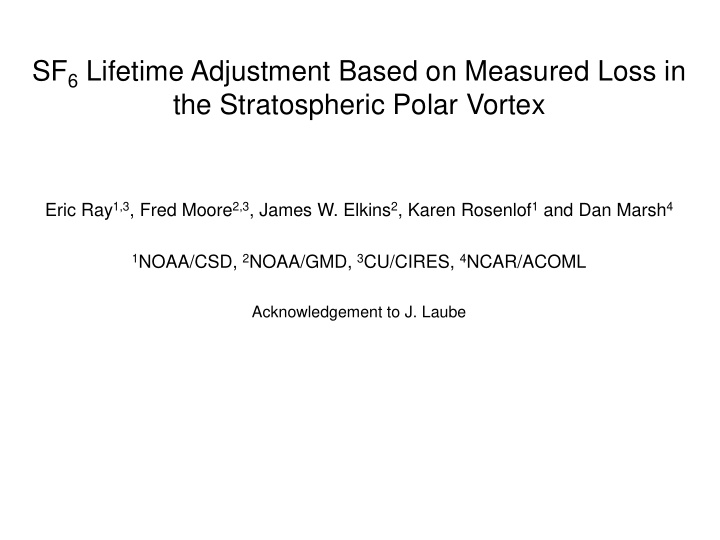



SF 6 Lifetime Adjustment Based on Measured Loss in the Stratospheric Polar Vortex Eric Ray 1,3 , Fred Moore 2,3 , James W. Elkins 2 , Karen Rosenlof 1 and Dan Marsh 4 1 NOAA/CSD, 2 NOAA/GMD, 3 CU/CIRES, 4 NCAR/ACOML Acknowledgement to J. Laube
Motivation and Objectives - Sulfur hexafluoride (SF 6 ) is a potent greenhouse gas and important tracer of stratospheric transport but has somewhat uncertain loss. - We use in situ measurements in the stratospheric polar vortex and mesospheric transport characteristics to derive annual SF 6 loss and estimate a revised SF 6 lifetime.
SF 6 Characteristics - Used primarily in the electrical industry as a dielectric medium, makes electricity grid more efficient therefore saves CO 2 emissions. - Potent greenhouse gas with one of the highest known radiative efficiencies (0.57 W/m 2 /ppbv) and the highest GWP for 100 year time horizon (23,500 based on 3200 year lifetime). - Mixing ratio is < 10 ppt and current growth rate is 4-5%/year. - Useful as a diagnostic of mean age of air in the stratosphere due to rapid growth and long lifetime. Rapid loss above Dominant loss mechanisms are Lyman- α photolysis - and electron attachment at altitudes > 50-60 km (details are somewhat uncertain). Transport time scale Totterdill et al., 2015
Upper Atmosphere Trace gases with lifetimes > ~300 years are likely to be destroyed in the mesosphere and above. Tough to make trace gas measurements above 35 km (except from satellites).
Mesospheric Descent Into Stratospheric Polar Vortex The entire mass of the mesosphere (several times over) descends into each of the stratospheric polar vortices every year!
Mesospheric Descent Into Stratospheric Polar Vortex Model trajectories show that air in the mesosphere can move from pole to pole in months. Air parcels descend and remain isolated in the vortex through March. Vortex edge in March
Mesospheric Descent Into Stratospheric Polar Vortex Circulation reverses in SH winter.
Measurements in the Stratospheric Polar Vortex As part of SOLVE campaign, Lightweight Airborne Chromatograph Experiment (LACE) measurements from balloon launch at Kiruna, Sweden on March 5, 2000.
Measured vs. Modeled Vortex Trace Gas Profiles Descent of tracers with Measured profile is mesospheric influence well representative in the vortex is well of the vortex. represented by WACCM.
Measurement Based Mean Age in Polar Vortex Difference tells us the amount of SF 6 loss “Real” mean age “Too old” mean age due to SF 6 photochemical loss
Inferred SF 6 Loss in Polar Vortex Nearly 50% SF 6 loss at the max balloon altitude. Translate the SF 6 -CO 2 mean age difference into SF 6 fractional loss based on growth rate.
Inferred SF 6 Loss in Polar Vortex Interpolate the SF 6 loss profiles to the top of the vortex under two different assumptions guided by WACCM.
Density Weighted SF 6 Loss in Polar Vortex Profile shape in upper strat has small effect on density weighted loss. Peak density weighted loss is in lower strat.
SF 6 Lifetime Calculation SF 6 loss per year is given by the integrated mass of the loss in both vortexes divided by the total mass of the atmosphere: SF 6 lifetime given by the inverse of the above annual loss rate is 800 to 900 years depending on upper vortex loss assumption with additional uncertainty of ±100 years due to uncertainty of vortex size. Assumptions 1. Mesospheric air only descends into the stratospheric polar vortexes. 2. We sampled representative polar vortex air mass.
Implications and Conclusions - Reduction of SF 6 lifetime from 3200 to 900 years only reduces GWP by 5% for 100 year time horizon, but 50-75% reduction for time horizons > 2000 years. - Hard to quantify overall radiative impact of SF 6 because it’s main use results in lower CO 2 emissions. - In situ measurements in the stratospheric polar vortex are useful for better understanding transport and photochemistry throughout the middle atmosphere.
Recommend
More recommend